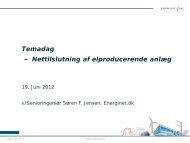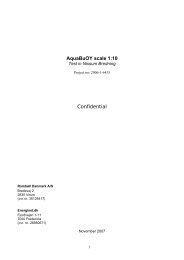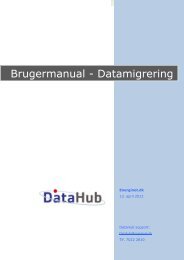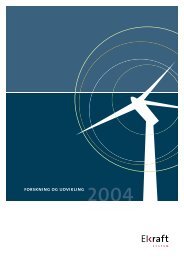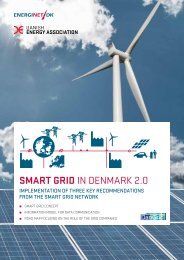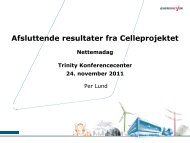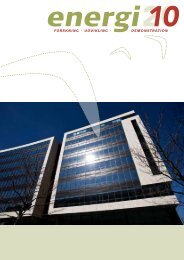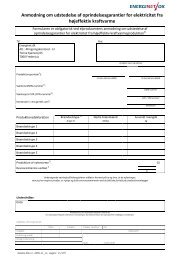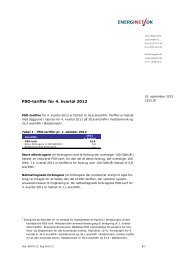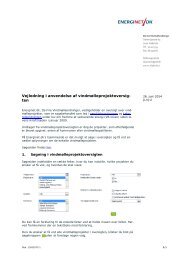Energinet.dk SOV
Energinet.dk SOV
Energinet.dk SOV
You also want an ePaper? Increase the reach of your titles
YUMPU automatically turns print PDFs into web optimized ePapers that Google loves.
Summary:<strong>Energinet</strong>.<strong>dk</strong> <strong>SOV</strong>Corporate Credit RatingAA/Stable/A-1+Profile AssessmentsBUSINESS RISKEXCELLENTVulnerableExcellentFINANCIAL RISKINTERMEDIATEHighly leveragedMinimal<strong>Energinet</strong>.<strong>dk</strong> <strong>SOV</strong>Primary Credit Analyst: Alf Stenqvist, Stockholm, (46) 8-440-5925; alf_stenqvist@standardandpoors.comSecondary Contact: John D Lindstrom, Stockholm, (46) 8-440-5922; john_lindstrom@standardandpoors.comAdditional Contact: Infrastructure Finance Ratings Europe; InfrastructureEurope@standardandpoors.comLikelihood Of Extraordinary Government SupportStandard & Poor's Ratings Services' 'AA' rating on the Danish state-owned transmission system operator (TSO)<strong>Energinet</strong>.<strong>dk</strong> <strong>SOV</strong> is based on our assessment of the company's stand-alone credit profile (SACP) at 'a' and ourexpectation of a "very high" likelihood that the Kingdom of Denmark would provide timely and sufficient extraordinarysupport to <strong>Energinet</strong> in the event of financial distress. Our assessment is based on <strong>Energinet</strong>'s:• "Very important" role as Denmark's monopoly TSO, including its clear public policy role in meeting the country'spower and gas requirements and environmental targets.• "Very strong" link with the Danish government, demonstrated by the company's full government ownership andremote privatization prospects and evidenced by the Act on <strong>Energinet</strong>, which stipulates that the overall electricityand gas infrastructure for which <strong>Energinet</strong> is responsible shall remain public property.RationaleWWW.STANDARDANDPOORS.COM/RATINGSDIRECT APRIL 24, 2013 21121028 | 301972520
Summary: <strong>Energinet</strong>.<strong>dk</strong> <strong>SOV</strong>Business Risk: Excellent• Excellent market position as Denmark's monopolyelectricity and gas TSO.• Transparent and supportive regulatory regime.• Efficient electricity transmission network.• Inherently weak return on capital as the companyoperates on a break-even basis.Financial Risk: Intermediate• Access to funding at short notice from thegovernment via the National Bank of Denmark.• No distribution of dividends to the state.• Sizable investment program, resulting in continuedhigh leverage and relatively weak credit metrics.Outlook: StableWe think that <strong>Energinet</strong> will remain focused on its core activities as a Danish monopoly TSO and continue to funditself primarily through government loans over the medium term. The outlook also reflects the likelihood that wecould affirm the ratings on <strong>Energinet</strong> even if we lowered our assessment of the company's SACP by one notch.This approach is in accordance with our criteria for government-related entities and our view of a "very high"likelihood of extraordinary government support for the company.Downside scenarioThe ratings could come under pressure if the current regulatory framework changed, with negative consequencesfor <strong>Energinet</strong>. We could also lower the ratings if our assessment of the level of state support weakened, whichcould result from a partial selloff. However, we consider the abovementioned changes to be relatively unlikely inthe medium term.Upside scenarioGiven the company's sizable investment program and limitations to increasing profitability because of theregulatory framework, we currently see limited upside potential for the ratings.Standard & Poor's Base-Case ScenarioUnder our base case, we expect <strong>Energinet</strong>'s credit measures to remain at current relatively weak levels in the next fewyears as a result of the company's significant investment program.WWW.STANDARDANDPOORS.COM/RATINGSDIRECT APRIL 24, 2013 31121028 | 301972520
Summary: <strong>Energinet</strong>.<strong>dk</strong> <strong>SOV</strong>Assumptions• <strong>Energinet</strong> continues to be able to pass all costs tocustomers as stipulated in the existing regulatoryframework.• Continued implementation of the current Danishkrone (DKK) 37 billion investment plan.Key Metrics2011A 2012E 2013ECapex (DKK)(1)* 2.2bil ~3bil ~4bilEBITDA interest coverage(1) 4.5x 5x-6x 5x-6xFFO-to-debt(1) 2.7%(2) 5%-7% 5%-7%(1)Fully Standard & Poor's-adjusted. A--Actual.E--Estimated. (2)The relatively low FFO-to-debt ratioin 2011 largely resulted from the effect of one-time taxpayments of DKK728 mil. Reported debt for 2011 isadjusted upward by DKK1.044 bil. consisting ofadjustments related to asset retirement obligations(DKK992 million) and accrued interest (DKK52million).Business Risk: Excellent<strong>Energinet</strong>'s business risk profile benefits from the group's strong market position as the monopoly electricity and gassystem operator in Denmark.In our view, the regulatory framework under which <strong>Energinet</strong> operates is stable and predictable; it has not changedsince 2005 when <strong>Energinet</strong> was created. The company is regulated through the Act on <strong>Energinet</strong>, which stipulates thatthe overall electricity and gas infrastructure that <strong>Energinet</strong> is responsible for shall remain public property. Theregulation of allowed return is based on cost-cover principles that permit <strong>Energinet</strong> to recognize necessary costs ofefficient operations plus a return on equity roughly equal to inflation. So far <strong>Energinet</strong> has never incurred a cost that ithas not been able to pass on to customers under the regulatory framework, supporting our view that the companyoperates an efficient network.<strong>Energinet</strong>'s profitability level is relatively low, with a return on capital in 2009-2011 averaging a meagre 4%. This is,however, natural, as the company operates as a nonprofit organization on a breakeven basis. We also note that thecompany has stable profitability levels enabled by the provision of a near-essential service under a supportivecost-cover regulatory regime.Under our base case, we expect <strong>Energinet</strong> to generate stable annual funds from operations (FFO) in the range ofDKK1.2 billion-1.5 billion.Financial Risk: Intermediate<strong>Energinet</strong>'s financial risk profile is underpinned by its access to loans, available at short notice, from the Danishgovernment via the Danish National Bank (not rated), and the fact that it does not distribute any profits or equity to theWWW.STANDARDANDPOORS.COM/RATINGSDIRECT APRIL 24, 2013 41121028 | 301972520
Summary: <strong>Energinet</strong>.<strong>dk</strong> <strong>SOV</strong>state.From an analytical standpoint, we treat the government loans as debt. However, in our view, these loans, which makeup almost 90% of <strong>Energinet</strong>'s reported debt significantly reduce the company's refinancing risk. This is an importantfactor that we take into account when assessing <strong>Energinet</strong>'s financial risk profile, as its credit measures, including theseloans in adjusted debt, are below the levels we normally would regard as commensurate with an "intermediate"financial risk profile. As a comparison, excluding the government loans from debt, the ratio of adjusted FFO to debtwould amount to around 20%-30% in 2012 under our base case.We also see the government loans as a strong sign of ongoing support from the owner. Each year <strong>Energinet</strong> presentsan investment and finance plan to the Ministry of Climate,Energy, and Building for the comingfour years, after whichthe ministry sets a borrowing limit based on the approved plan. <strong>Energinet</strong> can request and receive the funds from thenational bank, which acts as an agent in issuing government bonds, within three business days. We understand that<strong>Energinet</strong> pays interest equal to the Danish government's borrowing rate plus a small spread of 15 basis points to theMinistry of Finance for administration. In practice, <strong>Energinet</strong> can use this source of capital to fund all of its activitiesand to refinance all existing loans.Under our base case, we expect the company's FFO-to-debt to be in the mid-single digits in the next few years. This ismainly the result of an extensive investment program and the acquisition of regional transmission grids in August2012.Liquidity: ExceptionalThe short-term rating is 'A-1+'. We base our assessment of <strong>Energinet</strong>'s liquidity principally on the company's access togovernment loans and the added financial flexibility that this brings, as well as our anticipation of extraordinarygovernment support for <strong>Energinet</strong> if needed.<strong>Energinet</strong> has a policy of not holding cash on its balance sheet. Instead, it uses a commercial paper program ofSwedish krona 5 billion (about DKK4.5 billion or €600 million) to meet its short-term financing needs.Principal Liquidity Sources• Access to government loans via the Danish NationalBank, with current limits of DKK3.8 billion for 2013;and• FFO in 2013 of around DKK1.4 billion.Principal Liquidity Uses• Debt of about DKK1.9 billion maturing in 2013 ofwhich DKK500 million is commercial paper with theremainder being loans from the national bank; and• Capital expenditures of about DKK4 billion in 2013.Related Criteria And Research• Methodology: Management And Governance Credit Factors For Corporate Entities And Insurers, Nov. 13, 2012• Methodology: Business Risk/Financial Risk Matrix Expanded, Sept. 18, 2012• Methodology: Short-Term/Long-Term Ratings Linkage Criteria For Corporate And Sovereign Issuers, May 15, 2012WWW.STANDARDANDPOORS.COM/RATINGSDIRECT APRIL 24, 2013 51121028 | 301972520
Summary: <strong>Energinet</strong>.<strong>dk</strong> <strong>SOV</strong>• Methodology And Assumptions: Liquidity Descriptors For Global Corporate Issuers, Sept. 28, 2011• Principles Of Credit Ratings, Feb. 16, 2011• Rating Government-Related Entities: Methodology And Assumptions, Dec. 9, 2010• Stand-Alone Credit Profiles: One Component Of A Rating, Oct. 1, 2010• Use Of CreditWatch And Outlooks, Sept. 14, 2009• 2008 Corporate Criteria: Analytical Methodology, April 15, 2008• 2008 Corporate Criteria: Ratios And Adjustments, April 15, 2008Business And Financial Risk MatrixBusiness RiskFinancial RiskMinimal Modest Intermediate Significant AggressiveExcellent AAA/AA+ AA A A- BBB --HighlyLeveragedStrong AA A A- BBB BB BB-Satisfactory A- BBB+ BBB BB+ BB- B+Fair -- BBB- BB+ BB BB- BWeak -- -- BB BB- B+ B-Vulnerable -- -- -- B+ B B- or belowNote: These rating outcomes are shown for guidance purposes only. The ratings indicated in each cell of the matrix are the midpoints of the likelyrating possibilities. There can be small positives and negatives that would lead to an outcome of one notch higher or lower than the typical matrixoutcome. Moreover, there will be exceptions that go beyond a one-notch divergence. For example, the matrix does not address the lowest rungs ofthe credit spectrum (i.e., the 'CCC' category and lower). Other rating outcomes that are more than one notch off the matrix may occur forcompanies that have liquidity that we judge as "less than adequate" or "weak" under our criteria, or companies with "satisfactory" or better businessrisk profiles that have extreme debt burdens due to leveraged buyouts or other reasons. For government-related entities (GREs), the indicatedrating would apply to the standalone credit profile, before giving any credit for potential government support.WWW.STANDARDANDPOORS.COM/RATINGSDIRECT APRIL 24, 2013 61121028 | 301972520
Copyright © 2013 by Standard & Poor's Financial Services LLC. All rights reserved.No content (including ratings, credit-related analyses and data, valuations, model, software or other application or output therefrom) or any partthereof (Content) may be modified, reverse engineered, reproduced or distributed in any form by any means, or stored in a database or retrievalsystem, without the prior written permission of Standard & Poor's Financial Services LLC or its affiliates (collectively, S&P). The Content shall not beused for any unlawful or unauthorized purposes. S&P and any third-party providers, as well as their directors, officers, shareholders, employees oragents (collectively S&P Parties) do not guarantee the accuracy, completeness, timeliness or availability of the Content. S&P Parties are notresponsible for any errors or omissions (negligent or otherwise), regardless of the cause, for the results obtained from the use of the Content, or forthe security or maintenance of any data input by the user. The Content is provided on an "as is" basis. S&P PARTIES DISCLAIM ANY AND ALLEXPRESS OR IMPLIED WARRANTIES, INCLUDING, BUT NOT LIMITED TO, ANY WARRANTIES OF MERCHANTABILITY OR FITNESS FORA PARTICULAR PURPOSE OR USE, FREEDOM FROM BUGS, SOFTWARE ERRORS OR DEFECTS, THAT THE CONTENT'S FUNCTIONINGWILL BE UNINTERRUPTED, OR THAT THE CONTENT WILL OPERATE WITH ANY SOFTWARE OR HARDWARE CONFIGURATION. In noevent shall S&P Parties be liable to any party for any direct, indirect, incidental, exemplary, compensatory, punitive, special or consequentialdamages, costs, expenses, legal fees, or losses (including, without limitation, lost income or lost profits and opportunity costs or losses caused bynegligence) in connection with any use of the Content even if advised of the possibility of such damages.Credit-related and other analyses, including ratings, and statements in the Content are statements of opinion as of the date they are expressed andnot statements of fact. S&P's opinions, analyses, and rating acknowledgment decisions (described below) are not recommendations to purchase,hold, or sell any securities or to make any investment decisions, and do not address the suitability of any security. S&P assumes no obligation toupdate the Content following publication in any form or format. The Content should not be relied on and is not a substitute for the skill, judgmentand experience of the user, its management, employees, advisors and/or clients when making investment and other business decisions. S&P doesnot act as a fiduciary or an investment advisor except where registered as such. While S&P has obtained information from sources it believes to bereliable, S&P does not perform an audit and undertakes no duty of due diligence or independent verification of any information it receives.To the extent that regulatory authorities allow a rating agency to acknowledge in one jurisdiction a rating issued in another jurisdiction for certainregulatory purposes, S&P reserves the right to assign, withdraw, or suspend such acknowledgement at any time and in its sole discretion. S&PParties disclaim any duty whatsoever arising out of the assignment, withdrawal, or suspension of an acknowledgment as well as any liability for anydamage alleged to have been suffered on account thereof.S&P keeps certain activities of its business units separate from each other in order to preserve the independence and objectivity of their respectiveactivities. As a result, certain business units of S&P may have information that is not available to other S&P business units. S&P has establishedpolicies and procedures to maintain the confidentiality of certain nonpublic information received in connection with each analytical process.S&P may receive compensation for its ratings and certain analyses, normally from issuers or underwriters of securities or from obligors. S&Preserves the right to disseminate its opinions and analyses. S&P's public ratings and analyses are made available on its Web sites,www.standardandpoors.com (free of charge), and www.ratingsdirect.com and www.globalcreditportal.com (subscription) and www.spcapitaliq.com(subscription) and may be distributed through other means, including via S&P publications and third-party redistributors. Additional informationabout our ratings fees is available at www.standardandpoors.com/usratingsfees.WWW.STANDARDANDPOORS.COM/RATINGSDIRECT APRIL 24, 2013 71121028 | 301972520



